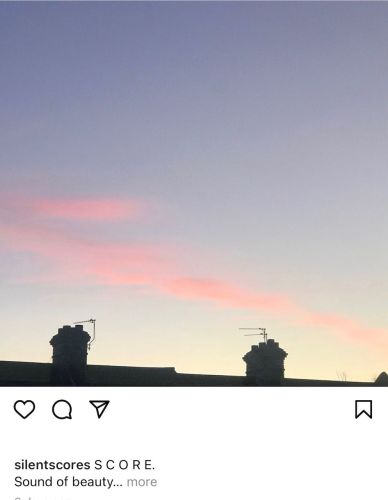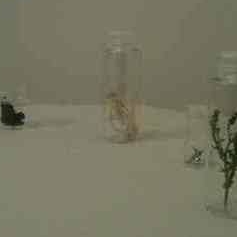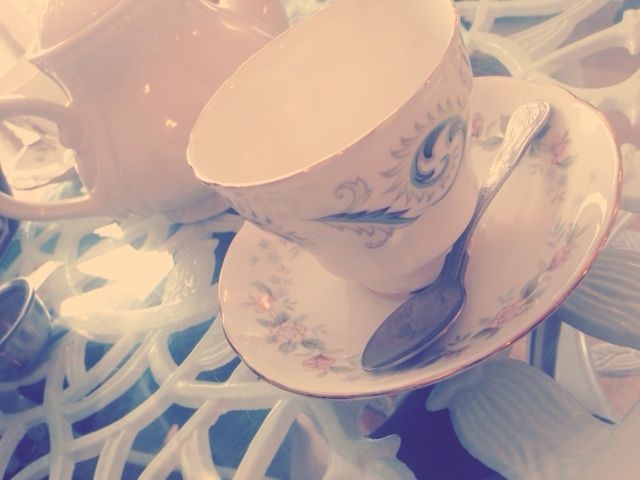aural scéance
Posted on
The room is almost completely dark, lit only by a projector screen and some fairy lights I have placed on the currently empty table. I breath slowly, trying to look calm and collected. I go over everything once more in my mind. Performance. Presentation. Participants discussion. The first person walks through the door, I smile and ask them to sit down anywhere, anywhere they like around the table.
No turning back now- let the séance begin.
Points of Listening is a monthly programme of experimental workshops centred on and around practices of listening, together. “It is an expanded and nomadic arena for practice and research that facilitates experimental scenarios with a participatory and performative emphasis.” ) It is co-convened by Salomé Voegelin and Mark Peter Wright in association with CRISAP, University of the Arts, London.
For my Points of Listening session, I have proposed to perform a live piece of art, newly created, called ‘Aural Séance’ with a post-performance presentation and discussion. The work is part of my current practice based PhD in sound art at UAL. My research degree investigates ‘inner sounds’ – sounds we hear as part of our inner worlds of thoughts, emotions and desires. It aims to call those sounds forward, to focus our attention on them, as well as define what they are and what they mean to us.
The table is full. Mark Peter Wright introduces the session and then it starts. I slowly walk up to the top of the table, look at the participants and start. I tell them how dangerous a séance can be. Tell them to focus, to close their eyes. I start to walk around the table, slowly. I summon the sound of darkness. The sound of fear. The sound of kindness. I keep walking around the table. I make sure they are aware of my presence by lightly touching their shoulder, their hair, their arm. Sometimes I stop, listening with one of them. I talk to them about the sound we are both listening for.
‘Aural Séance’ aims to, first and foremost, to focus our attention towards our capacity for inner listening, inner sounds. Through my research, I have found that – perhaps because we are a culture focused on the visual in many ways, perhaps for other reasons - people frequently start by telling me they never hear inner sounds, that they don’t exist. I have devised various strategies for focusing your mind ‘sonically’, to listen inwards. Often, those same people who told me that they don’t hear inner sounds will speak to me again, later, maybe hours or days or weeks later, and tell me they DO hear inner sounds, they just never paid attention to them before. ‘Aural Séance’ aims to re-focus the participants attention towards these internal sounds.
" ‘Aural Séance’ aims to, first and foremost, to focus our attention towards our capacity for inner listening, inner sounds. "
How, then, can we hear without our ears? We are all aware of the expression ‘our minds eye’ – but do we have a corresponding ‘minds ear’? This question has been present in my research throughout - if we need our ears to listen, how can we then listen to our minds? One way of theorising and thinking through this issue has been with the help of French philosopher Maurice Merlau-Ponty. He argues that we are wrong to divide our experience into ‘body’ and ‘mind’ – we experience things as one being, as what he calls a ‘body-subject’ – an intertwining of body and mind. Thinking of hearing in this way means we can talk about a thinking body, but also, more importantly, a hearing mind. Merleau-Ponty also argues that there is not as clear a border as we would like to think between ourselves and the outer world. He speaks of experience and ‘pre-personal’ – the ‘I’, he argues, comes later with reflection. In the moment of experience, the border between us and the world is shifting, porous, changing. ‘Aural Séance’ uses the format of a Victorian style séance to explore this theme of ‘openness’ within inner listening. The idea first started to take shape while reading Lisa Blackmans book ‘Immaterial Bodies (2012)’, in which she discusses threshold experiences, which she defines as: “phenomena which suggests some kind of transport between the self and other, inside and outside, and material and immaterial” (Blackman, p 20) A séance is interesting in this context, as it’s an experience which raises questions about the ‘contained’ nature of our inner selves. It consists of a group of people listening for, looking for or feeling towards ONE thing, sensation, spirit or sound. Frequently, the group of séance participants report they all experienced the same thing. This still stands whether you believe in the spirit world or think their experiences are just based on suggestion – a group of people somehow shared in a ‘inner’ experience.
In ‘Aural Séance’ a group of participants are asked to all listen towards the same ‘inner’ sound. The sound prompts are designed to be abstract, to avoid triggering an obvious, recognised sound – the ‘sound of water’ is not used, but rather the sound of kindness, darkness etc. The participants are aware both of each other, and of the facilitator/artists presence in the space, and their listening towards the same sounds as they are. To further highlight this, and create a sense of a shared inner listening experience, I stop and listen WITH individual participants throughout the séance – talking to them about the sound we are both listening towards, while lightly touching their arm, their shoulder or just leaning against their chair.
The séance comes to an end. I stop at the head of the table, and ask everyone to take a deep breath. Slowly open their eyes. I warn them that they should leave any sound they heard behind in this space, as they might otherwise haunt them in their daily lives. I walk out of the room and turn on the lights.
After performing the piece to the group, I have designed a short presentation to start discussion on the themes of the work. As is often the case, people are keen to discuss inner sounds, what they are, could they hear them? As I try to move the discussion on to other topics, such as he definition of ‘inner’ and how listening, inner listening and seances starts to question our understanding of it, the participants linger on inner sounds. Some of them are sound artists, and want to know if I have advice for listening inwards. Some of them wants me to describe the sounds I hear. Some want to talk about the sound of dreams. They are an amazingly generous group of people, all willing to share experiences and discuss the work and how it affected them. I am left with the feeling of moving to quickly, of retrospectively wishing I allowed more time just to discuss inner sounds.
"As is often the case, people are keen to discuss inner sounds, what they are, could they hear them?"
I have been both excited and nervous about doing a Points of Listening session for a long time, and I’m so glad I finally did one. Reflecting on the session, what was said, the work and its contexts has since defined an area which looks a lot like a chapter for my PhD. Performing your work, and then allowing a discussion and feedback on it might seem like a daunting thing to do (it did to me anyway!) but it was worth it.
Can YOU hear the sound of nothing?
Yes
What does it sound like?
(Silent listening)
Previously published on the UAL Post Graduate Blog


